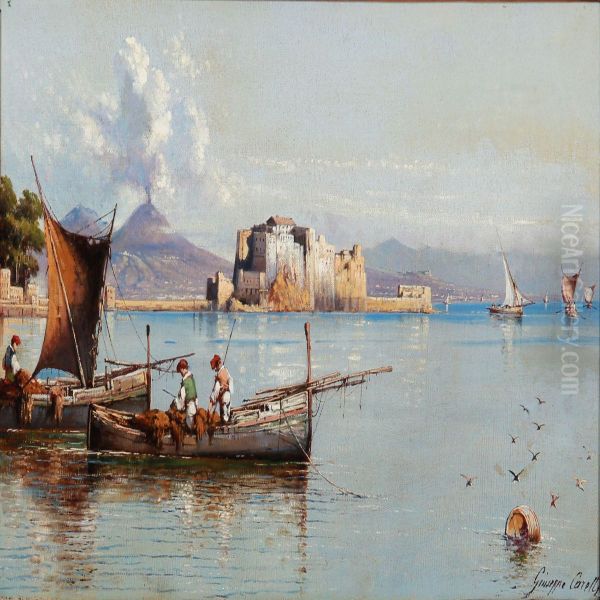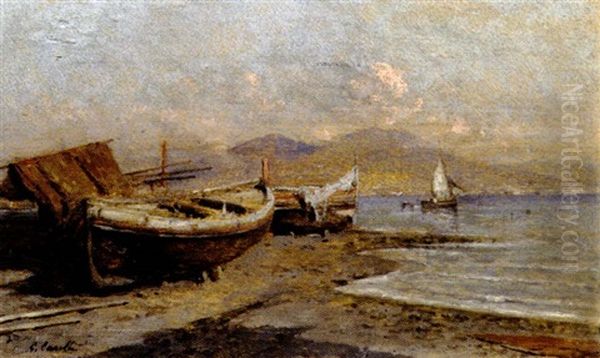Giuseppe Carelli (1858-1921) was an Italian artist known primarily for his evocative landscape paintings. Born in the vibrant city of Naples, a place renowned for its stunning natural beauty and rich artistic heritage, Carelli dedicated much of his career to capturing the unique light and atmosphere of his native region. His work provides a valuable window into the Neapolitan landscape as it appeared in the late 19th and early 20th centuries.
Coming from a family deeply rooted in the arts, Giuseppe was immersed in a creative environment from a young age. This familial connection to painting undoubtedly shaped his artistic path and provided him with foundational training and inspiration, linking him to a significant lineage within Italian art history.
The Carelli Artistic Dynasty
Giuseppe Carelli was not the only artist in his family; indeed, he hailed from a veritable dynasty of painters. His father was the celebrated landscape painter Raffaele Carelli (1818-1900), a prominent figure associated with the School of Posillipo. This school, known for its direct observation of nature and focus on light and atmosphere, profoundly influenced landscape painting in Naples and beyond. Raffaele's success and reputation provided a strong artistic backdrop for his children.
Giuseppe's brothers, Consalvo Carelli (1818-1900 – Note: Dates often cited similarly to Raffaele, suggesting potential confusion or close birth years, though Consalvo is generally considered the elder) and Achille Carelli (1856-1936), were also accomplished painters. Consalvo, in particular, achieved significant recognition, travelling extensively and gaining patronage abroad, including support from the 6th Duke of Devonshire in England, where he spent considerable time. Some historical accounts occasionally conflate the activities of the Carelli family members, attributing travels or specific commissions meant for Consalvo or Raffaele to Giuseppe.
It is important to distinguish Giuseppe's specific contributions within this talented family. While his father and brother Consalvo might have achieved wider international fame during their lifetimes, Giuseppe carved out his own niche, focusing intently on the landscapes of Naples and its surroundings, continuing the family tradition while developing his own perspective. His connection to this artistic lineage places him firmly within the narrative of 19th-century Neapolitan painting.
Artistic Focus: Naples and Vesuvius

The Bay of Naples, with its dramatic coastline, sparkling waters, and the ever-present silhouette of Mount Vesuvius, served as the primary muse for Giuseppe Carelli. His works frequently depict the bustling life of the bay, the tranquil shores, and the picturesque islands scattered across the water. He was particularly drawn to capturing the interplay of light on the sea and land, a hallmark of the Neapolitan landscape tradition.
Carelli often included Mount Vesuvius in his compositions, portraying it not just as a scenic backdrop but sometimes hinting at its powerful, volatile nature. The source materials mention his keen observation of natural phenomena, suggesting an interest in depicting the volcano in its various moods, possibly including representations related to its eruptions, which were a recurring and dramatic feature of life in the region.
Specific paintings highlight his dedication to these themes. Works such as Fishermen in the Gulf of Naples showcase typical scenes of local life set against the iconic panorama featuring Vesuvius. Another significant work mentioned is Bucht von Neapel mit Castel dell'Ovo (Bay of Naples with Castel dell'Ovo), an oil painting dated 1921, which captures the historic fortress jutting into the bay, a beloved landmark of the city. Paintings like Barche in secca nel golfo di Napoli (Boats aground in the Bay of Naples) further demonstrate his focus on maritime subjects and coastal views.
Style and Technique
Giuseppe Carelli worked predominantly in oil paint, the traditional medium for landscape painters of his era. His style appears to be rooted in the Neapolitan landscape tradition, which evolved from the earlier School of Posillipo. This tradition emphasized plein air (open air) observation, although finished works were often completed in the studio. His paintings likely combined direct observation with established compositional techniques.
While some source descriptions confusingly mention "classical portraiture," Carelli is overwhelmingly identified as a landscape painter. His approach likely blended the atmospheric sensitivity of the Posillipo School, inherited perhaps through his father Raffaele, with the growing influence of Realism prevalent in the latter half of the 19th century. This would involve careful attention to detail, accurate rendering of topography and light, and an objective yet appreciative portrayal of the chosen scene.

The sources suggest his works feature clear lines and rich detail, aiming for a faithful representation of the Neapolitan environment. Unlike the more revolutionary styles emerging elsewhere in Europe, Carelli's work seems to have remained within the bounds of representational landscape painting, focusing on capturing the beauty and specificity of his local surroundings. Unfortunately, detailed accounts of his specific working methods or unique habits during the creative process are scarce, as noted in the provided texts.
Training and Influences
Giuseppe Carelli received his formal art education in his hometown at the Accademia di Belle Arti di Napoli (Naples Academy of Fine Arts). This institution was a central hub for artistic training in Southern Italy. During his studies, one source tentatively suggests he may have been a student of Jakob Wilhelm Huber, a Swiss-born painter active in Naples, potentially serving as his assistant later on. However, given the inconsistencies in the source material regarding teachers and students (especially the erroneous link to Giovanni Battista Somis, a student of the composer Arcangelo Corelli), this connection should be viewed with caution.
Beyond specific teachers, Carelli was undoubtedly influenced by the pervasive artistic environment of Naples. The legacy of the School of Posillipo, established by artists like the Dutch painter Anton Sminck van Pitloo and carried forward by Italians such as Giacinto Gigante, was inescapable. These artists championed a more naturalistic and luminous approach to landscape compared to the earlier, more formal veduta tradition. Giuseppe's father, Raffaele Carelli, was a direct participant in this school, ensuring Giuseppe absorbed its principles.
Furthermore, the broader currents of 19th-century Italian art would have played a role. The move towards Realism (Verismo in Italy) influenced many Neapolitan artists. Painters like Giuseppe De Nittis (though he worked mostly in Paris) and Federico Rossano explored more objective depictions of modern life and landscape, which may have informed Carelli's later work, tempering the romanticism of the earlier Posillipo style.
Contemporaries and Context in Naples
Giuseppe Carelli worked during a period when Naples remained an important, albeit perhaps less dominant, center for Italian art compared to its peak earlier in the century. He shared the artistic stage with numerous other painters who depicted the city and its environs. Understanding his contemporaries helps place his work within the broader artistic milieu of late 19th and early 20th century Naples.
Among the notable Neapolitan and Southern Italian painters active during Carelli's career were figures like Edoardo Dalbono, known for his historical scenes and luminous Neapolitan views; Francesco Paolo Michetti, a versatile artist from the Abruzzo region whose work often depicted local peasant life with vibrant realism; and Vincenzo Irolli, celebrated for his lively genre scenes capturing the energy of Neapolitan street life.
Other landscape and genre painters contributing to the scene included Attilio Pratella, who specialized in views of Naples, particularly its bustling port and coastal areas, often with an impressionistic touch; Luca Postiglione, known for both genre scenes and portraits; and Vincenzo Caprile, another artist dedicated to capturing the picturesque aspects of Naples and the nearby islands like Capri. These artists, along with many others, formed the rich tapestry of Neapolitan painting against which Giuseppe Carelli developed his own artistic voice. While perhaps not as innovative as some, Carelli contributed steadily to the enduring tradition of Neapolitan landscape painting.
Recognition and Legacy
Giuseppe Carelli's works continue to appear on the art market, indicating sustained interest among collectors of traditional Italian landscape painting. Auction records, such as the sale of Fishermen in the Gulf of Naples for prices around €2,200 to €3,066 (as cited in the sources), demonstrate that his paintings hold commercial value. His depictions of classic Neapolitan views remain appealing for their charm and historical documentation.
However, compared to his father Raffaele or his brother Consalvo, Giuseppe's individual fame and critical assessment seem less pronounced in broader art historical narratives. The source materials themselves note a lack of detailed historical evaluation concerning his specific impact or influence. He appears to be recognized primarily as a competent and dedicated member of the Carelli family, contributing reliably to the genre of Neapolitan landscape painting.
His legacy lies chiefly in his consistent production of works that celebrate the beauty of the Naples region. Through his paintings, he helped perpetuate the artistic fascination with the Bay of Naples, Vesuvius, and the surrounding coastal towns, offering pleasant and well-executed views that appealed to both locals and visitors drawn to the area's famed scenery. He represents a continuation of a specific regional painting tradition into the early 20th century.
Distinguishing Giuseppe Carelli: Clarifying Confusions
It is essential to reiterate the distinctions between Giuseppe Carelli and other individuals with similar names, especially given the significant confusion present in the provided source materials. Firstly, he must be distinguished from other members of his own artistic family. His father, Raffaele Carelli, and his brother, Consalvo Carelli, were distinct artists with their own careers and reputations. Activities like Consalvo's extended stay in London and connections with figures like the Duke of Devonshire or Alexandre Dumas belong to Consalvo, not Giuseppe.
Secondly, and perhaps most importantly, Giuseppe Carelli the painter (1858-1921) must absolutely not be confused with the highly famous Baroque composer and violinist Arcangelo Corelli (1653-1713). The source texts erroneously included substantial information about Arcangelo Corelli, including his influence on violin music, his composition of the "Christmas Concerto," and his students like Giovanni Battista Somis and Antonio Vivaldi. This information is entirely unrelated to Giuseppe Carelli the painter. Such errors highlight the importance of careful verification when researching historical figures. Giuseppe Carelli's life and work belong firmly to the world of late 19th and early 20th century Italian painting.
Conclusion
Giuseppe Carelli stands as a noteworthy figure within the context of Neapolitan landscape painting, particularly as a member of the distinguished Carelli artistic family. Active from the late 19th century into the early 20th century, he dedicated his art to capturing the enduring beauty of the Bay of Naples, Mount Vesuvius, and the surrounding coastal scenery. Working primarily in oils, his style likely reflected the legacy of the School of Posillipo combined with elements of Realism common in his time.
While perhaps overshadowed in historical accounts by his father Raffaele and brother Consalvo, and sometimes confused with unrelated figures like the composer Arcangelo Corelli, Giuseppe Carelli made his own contribution. His paintings offer valuable depictions of the Neapolitan landscape, appreciated for their faithfulness, detail, and connection to a long tradition of representing one of Italy's most iconic regions. He remains a figure of interest for collectors and those studying the rich history of painting in Naples.